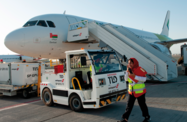Work on Oman’s national rail network – part of a wider system linking all the countries of the GCC – is picking up pace, with advanced planning work now under way and construction set to begin next year.
The state-owned Oman National Railway Company recently announced it was opening the pre-qualification tender to provide infrastructure and information technology systems for the initial stage of the 2244-km network. The tender, open to local and foreign bidders, covers the construction of the first section, which runs from the border with the UAE at Al Buraimi to the port of Sohar. The projected cost of this phase is around $2.6bn, with the expense of the full project expected to amount to $15bn.
Ahead of the opening of the pre-qualification process, Oman had sealed a series of agreements that have laid the groundwork for the railway. Central to this was the awarding of a $36m contract to Italian rail engineering firm Italferr, which is to act as the preliminary design consultant for the project and has already begun work. Construction on the first stages is due to start in early 2015, with contracts set to be tendered for the initial building phase later this year.
To finance at least part of the work, Oman may issue debt of up to $3bn. According to Oman National Railway Company officials, both conventional bonds and sukuk are being considered. Some contracts could be structured as public-private partnerships, with the winning bidders taking on financial and operating risks.
Oman’s extended network
The GCC rail network has been in development since 2008, when the member states’ transport ministers agreed to undertake a feasibility study. This resulted in an agreement to back the project, which foresaw the construction of a network running up to the Iraqi border and terminating at Muscat.
However, rather than have the final terminus at the capital, Oman’s government decided to run the line across the country to the Arabian Sea coast and then down to the Yemeni border, leaving open the option of extending the network further south.
According to Abdulrahman Al Hatmi, one of the directors of the Oman National Railway Company, the decision to carry the network to the industrial port cities of Duqm and Salalah will have a major positive impact on the economy.
While acknowledging that extending the network to the two ports was an expensive proposition, Al Hatmi said the opportunities that would be opened up would more than justify the cost, both in terms of economics and transport security.
“One of the key changes we’ve made is to connect to Salalah, which is the mouth of the region and will play a major role in transforming the whole logistics map,” he told Bloomberg on February 6.
By extending the line to Duqm and Salalah, Oman would offer an alternative route for freight transport should regional tensions disrupt shipping through the Strait of Hormuz. More importantly, the rail link will allow Oman’s ports on the Arabian Sea and its logistics sector to achieve their full potential. International shipping firms may find it quicker to berth vessels in Omani harbours and have their cargoes shipped across the country by rail to destinations around the region, rather than face delays at congested ports inside the Gulf.
According to Vic Allen, acting CEO of the Oman Airports Management Company, the national rail plans complement Oman’s airports expansion project and capitalise on the country’s strategic location. “Once the projects are completed, Oman will be well-placed to connect the GCC to African markets,” he told OBG.
Vital connections
One challenge facing Oman, at least in the shorter-term, is the uneven progress being made across the Gulf-wide network. Solid headway has been made on some parts of the international grid, including in Saudi Arabia and the UAE. However, other states have not made such progress. Reports suggest, for example, that Kuwait’s section of the network will not be completed before 2019 at the earliest, a year behind schedule.
In the short term, gaps in the network at the regional level would devalue to a degree the ability of the grid to deliver freight quickly and cost effectively. This would be especially costly for Oman, given its ambitions to be the first (or last) station on the line.
Follow Oxford Business Group on Facebook, Google+ and Twitter for all the latest Economic News Updates. Or register to receive updates via email.

